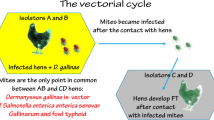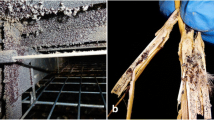Abstract
The poultry red mite, Dermanyssus gallinae, is a blood-feeding parasite of layer hens and a potential vector of several avian infectious agents. High infestation with D. gallinae in layer farm buildings could result in economic losses, and the mites may act as a reservoir of avian pathogens within farms. This study aimed to assess the prevalence of D. gallinae in layer farm buildings in Korea and to investigate avian pathogens in the collected mites. The mite samples were collected from 36 Korean layer farm buildings on 21 farms nationwide. Information obtained from each farm building included the flock size, flock age, methods for controlling D. gallinae, and cleaning status. Association between these variables and the population density of D. gallinae was analyzed. Additionally, the presence of 10 avian pathogens was assessed using DNA samples from mites collected in 16 farm buildings. The prevalence of D. gallinae was 75% at the farm building level (90.5% at the farm level). Repetitive cleaning procedures for each building were significantly related with the mite infestation level, and the most influential factor for determining the mite population in the layer farm buildings. In the 16 DNA samples, we detected avian pathogenic Escherichia coli (n = 6), wild-type fowlpox virus (n = 3), wild-type Marek’s disease virus (n = 2), chicken anemia virus (n = 1), and fowl adenovirus (n = 1). These findings suggest that repetitive cleaning procedures for the layer farm buildings could decrease the numbers of D. gallinae which may transmit avian pathogens within the farm.

Similar content being viewed by others
References
Arzey G (1990) Mechanisms of spread of Newcastle disease. NSW Agric Fish 42:12
Boodhoo N, Gurung A, Sharif S, Behboudi S (2016) Marek’s disease in chickens: a review with focus on immunology. Vet Res 47:119
Chauve C (1998) The poultry red mite Dermanyssus gallinae: current situation and future prospects. Vet Parasitol 8:364–376
Chikuba T, Itou H, Sakakibara H, Inoue D (2008) Detection of fowlpox virus from red mite (Dermanyssus gallinae) at a layer farm occurring cutaneous fowlpox. J Japan Soc Poult Dis (Japan) 44:113–117
Chirico J, Eriksson H, Fossum O, Jansson D (2003) The poultry red mite, Dermanyssus gallinae, a potential vector of Erysipelothrix rhusiopathiae causing erysipelas in hens. Med Vet Entomol 17:232–234
Durden LA, Linthicum KJ, Monath TP (1993) Laboratory transmission of eastern equine encephalomyelitis virus to chickens by chicken mites (Acari: Dermanyssidae). J Med Entomol 30:281–285
Eltahir YM, Qian K, Jin W, Wang P, Qin A (2011) Molecular epidemiology of chicken anemia virus in commercial farms in China. Virol J 8:145
Eriksson H, Brännström S, Skarin H, Chirico J (2010) Characterization of Erysipelothrix rhusiopathiae isolates from laying hens and poultry red mites (Dermanyssus gallinae) from an outbreak of erysipelas. Avian Pathol 39:505–509
Flochlay AS, Thomas E, Sparagano O (2017) Poultry red mite (Dermanyssus gallinae) infestation: a broad impact parasitological disease that still remains a significant challenge for the egg-laying industry in Europe. Parasit Vectors 10:357
García M, Narang N, Reed WM, Fadly AM (2003) Molecular characterization of reticuloendotheliosis virus insertions in the genome of field and vaccine strains of fowl poxvirus. Avian Dis 47:343–354
George DR, Finn RD, Graham KM, Mul MF, Maurer V, Moro CV, Sparagano OA (2015) Should the poultry red mite Dermanyssus gallinae be of wider concern for veterinary and medical science? Parasit Vectors 8:1–10
Hamidi A, Sherifi K, Muji S, Behluli B, Latifi F, Robaj A, Postoli R, Hess C, Hess M, Sparagano O (2011) Dermanyssus gallinae in layer farms in Kosovo: a high risk for Salmonella prevalence. Parasit Vectors 4:136
Houng CTT, Murano T, Uno Y, Usui T, Yamaguchi T (2014) Molecular detection of avian pathogens in poultry red mite (Dermanyssus gallinae) collected in chicken farms. J Vet Med Sci 76:1583–1587
Hu Q, Tu J, Han X, Zhu Y, Ding C, Yu S (2011) Development of multiplex PCR assay for rapid detection of Riemerella anatipestifer, Escherichia coli, and Salmonella enterica simultaneously from ducks. J Microbiol Methods 87:64–69
Knöbl T, Micke Moreno A, Paixao R, Gomes TAT, Vieira MAM, da Silva Leite D, Blanco JE, Ferreira AJP (2012) Prevalence of avian pathogenic Escherichia coli (APEC) clone harboring sfa gene in Brazil. Sci World J. https://doi.org/10.1100/2012/437342
Kumar A, Chandraprakash M, Maan N, Mahajan N, Batra K, Ghosh A, Nanda T, Maan S (2014) Assessment of different template preparation methods for nested PCR based detection of Marek’s disease virus of poultry. J Cell Tissue Res 14:4519
Meng F, Dong G, Zhang Y, Tian S, Cui Z, Chang S, Zhao P (2018) Co-infection of fowl adenovirus with different immunosuppressive viruses in a chicken flock. Poultry Sci 97:1699–1705
Moro CV, Fravalo P, Amelot M, Chauve C, Zeener L, Salvat G (2007) Colonization and organ invasion in chicks experimentally infected with Dermanyssus gallinae contaminated by Salmonella Enteritidis. Avian Pathol 36:307–311
Moro CV, Chauve C, Zenner L (2007) Experimental infection of Salmonella Enteritidis by the poultry red mite, Dermanyssus gallinae. Vet Parasitol 146:329–336
Moro CV, De Luna CJ, Tod A, Guy JH, Sparagano OA, Zenner L (2009) Poultry red mite (Dermanyssus gallinae): a potential vector of pathogenic agents. Exp Appl Acarol 48:93–104
Moro CV, Fravalo P, Amelot M, Chauve C, Salvat G, Zenner L (2010) Experimental studies on the potential role of the poultry red mite, Dermanyssus gallinae, as a vector of Salmonella serotype Enteritidis. In: Sabelis M, Bruin J (eds) Trends in acarology. Springer, Dordrecht, pp 521–525
Nordenfors H, Höglund J, Uggla A (1999) Effects of temperature and humidity on oviposition, moulting and longevity of Dermnanyssus gallinae (Acari: Dermanyssidae). J Med Entomol 36:68–72
Oh SI, Noh G, Yi SW, Do YJ, Kim E, Yoo JG (2019) Molecular epidemiological characterization of poultry red mite (Dermanyssus gallinae) collected from Korea. Korean J Vet Serv 42:161–167
Oh SI, Park KT, Jung Y, Do YJ, Choe C, Cho A, Kim S, Yoo JG (2020) A sampling and estimation method for monitoring poultry red mite (Dermanyssus gallinae) infestation on caged-layer poultry farms. J Vet Sci. https://doi.org/10.4142/jvs.2020.21.e41
Petrov D (1975) Study of Dermanyssus gallinae as a carrier of Pasteurella multocida. Veterinarno-meditsinski nauki 12:32–36
Raele D, Galante D, Pugliese N, La Salandra G, Lomuto M, Cafiero MA (2018) First report of Coxiella burnetii and Borrelia burgdorferi sensu lato in poultry red mites, Dermanyssus gallinae (Mesostigmata, Acari), related to urban outbreaks of dermatitis in Italy. New Microbes New Infect 23:103–109
Shirnov F, Ibragimova A, Misirov Z (1972) The dissemination of the fowl-pox by the mite Dermanyssus gallinae. Veterinarya 4:48–49
Singh P, Schnitzlein WM, Tripathy DN (2003) Reticuloendotheliosis virus sequences within the genomes of field strains of fowlpox virus display variability. J Virol 77:5855–5862
Sparagano O, Pavlićević A, Murano T, Camarda A, Sahibi H, Kilpinen O, Mul M, Van Emous R, Le Bouquin S, Hoel K (2009) Prevalence and key figures for the poultry red mite Dermanyssus gallinae infections in poultry farm systems. Control of poultry mites (Dermanyssus). Exp Appl Acarol 48:3–10
Sparagano O, George D, Harrington D, Giangaspero A (2014) Significance and control of the poultry red mite, Dermanyssus gallinae. Ann Rev Entomol 59:447–466
Takeshi K, Makino S, Ikeda T, Takada N, Nakashiro A, Nakanishi K, Oguma K, Katoh Y, Sunagawa H, Ohyama T (1999) Direct and rapid detection by PCR of Erysipelothrix sp. DNAs prepared from bacterial strains and animal tissues. J Clin Microbiol 37:4093–4098
Townsend KM, Frost AJ, Lee CW, Papadimitriou JM, Dawkins HJ (1998) Development of PCR assays for species-and type-specific identification of Pasteurella multocida isolates. J Clin Microbiol 36:1096–1100
Waap H, Nunes T, Mul M, Gomes J, Bartley K (2019) Survey on the prevalence of Dermanyssus gallinae in commercial laying farms in Portugal. Avian Pathol. https://doi.org/10.1080/03079457.2019.1606415
Wang H, Fadl A, Khan M (1997) Multiplex PCR for avian pathogenic mycoplasmas. Mol Cell Probes 11:211–216
Zhao S, Maurer JJ, Hubert S, De Villena JF, McDermott PF, Meng J, Ayers S, English L, White DG (2005) Antimicrobial susceptibility and molecular characterization of avian pathogenic Escherichia coli isolates. Vet Microbiol 107:215–224
Ziemer C, Steadham S (2003) Evaluation of the specificity of Salmonella PCR primers using various intestinal bacterial species. Lett Appl Microbiol 37:463–469
Acknowledgements
The authors would like to thank Guntai Noh for his technical support. We are also grateful to the farmers who participated in the study especially for their cooperation and willingness to provide information about their own farms.
Funding
This work was carried out with the support of “Cooperative Research Program for Agriculture Science and Technology Development (Project title: Development of monitoring techniques for poultry red mite (Dermanyssus gallinae), Project No. PJ01345502)”, Rural Development Administration, Republic of Korea.
Author information
Authors and Affiliations
Contributions
SIO and JGY conceived and designed the study. SIO, YJD, EK, and SWY processed the sample collection and data analyses. SIO and JGY contributed to writing the manuscript. All authors read and approved the final version of the manuscript.
Corresponding author
Ethics declarations
Conflict of interest
The authors declare no conflict of interest related to this study.
Ethical approval
This study was approved by the National Institute of Animal Science, Republic of Korea (Approval No. 2018-269).
Additional information
Publisher's Note
Springer Nature remains neutral with regard to jurisdictional claims in published maps and institutional affiliations.
Rights and permissions
About this article
Cite this article
Oh, SI., Do, Y.J., Kim, E. et al. Prevalence of poultry red mite (Dermanyssus gallinae) in Korean layer farms and the presence of avian pathogens in the mite. Exp Appl Acarol 81, 223–238 (2020). https://doi.org/10.1007/s10493-020-00502-5
Received:
Accepted:
Published:
Issue Date:
DOI: https://doi.org/10.1007/s10493-020-00502-5




